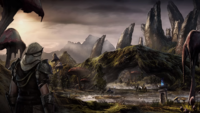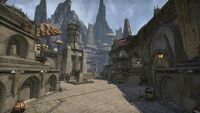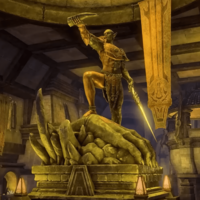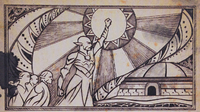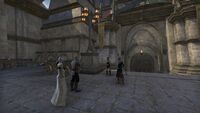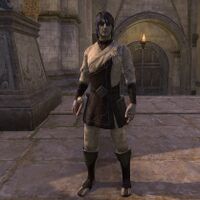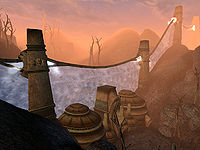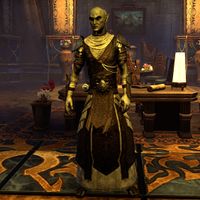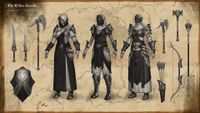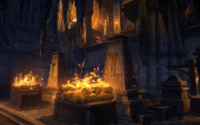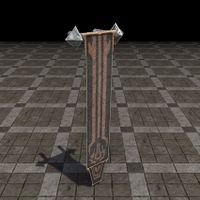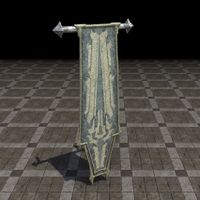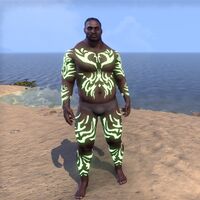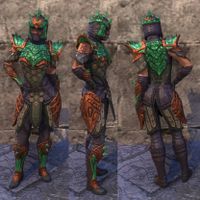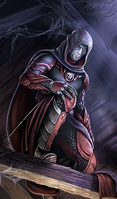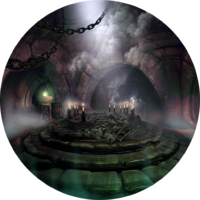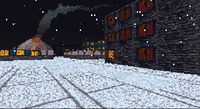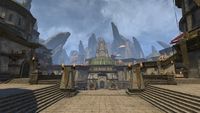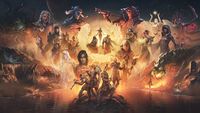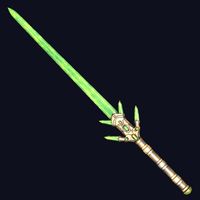Lore:Necrom
| Necrom | |
|---|---|
| Type | Settlement |
| Continent | Tamriel |
| Province | Morrowind |
| Region | Padomaic Crest |
| Demonym(s) | Necromic[1] |
| Appears in | Arena, ESO, Legends |
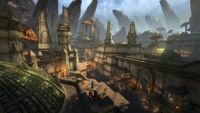
|
Necrom is one of the eight major cities on the mainland of Morrowind,[2] and is perched on the Padomaic Ocean, right on the eastern edge of the Padomaic Crest. The city is the center of ancestor worship in Morrowind and has thus earned the moniker, the City of the Dead.[3] But despite the nature of this name, Necrom can be a teeming and bustling metropolis for commerce, pilgrims, and the mournful all day and night.[3][4] While modern Dunmer left their ancient customs behind, Necrom helps them re-connect with that lost part of their history and their ancestry.[5]
Throughout its history Necrom has been traditionally ruled by the Keepers of the Dead, a monastic order that serve as caretakers of the city and its necropolis.[6][7] The Keepers answer to the authority of the Temple.[8] The eastern coast is presently ruled over by House Indoril,[9] which as of the Fourth Era, is considered one and the same with the New Temple.[10]
Layout and Geography[edit]
Necrom is a dense cityscape built on a steep, mountainous island, surrounded by perilous cliffs,[11] and at the mouth of the river that divides the eastern peninsula's southern region. Despite its inaccessibility from the outside, its people have taken advantage of the terrain to accommodate pilgrims coming in and out of the city. In its heyday, wooden ramps were built over the ravines for ease of access, and since then, marble causeways cover them, although some can still hear them echo inside.[5] Necrom's architectural style is noted for its lofty walls and white towers.[3]
The Necrom outskirts comprise of steep hills and winding roads strewn up and across the small river valley around it. Travelers on foot can enter the city either through the outer gate, a fortified outpost just across the valley that connects via a large marble bridge, or the underpasses at the bottom that scale up toward the city walls. Off this beaten path is the Silt Strider tower.[11] Just off the coast, north of Necrom is the island of Gorne,[12][13] which is historically owned by House Indoril.[14][15] Necrom is neighbored by several settlements, one of which includes Sailen Vulgate to the west.[2]
Necrom's main entrance is the southern inner gate and it is where all these paths come together. The city's layout is like an intertwined web that meets at several points. From the main entrance, travelers are greeted by the large, open-aired trading plaza that is anchored from the other side by the local wayshrine. The long street that intersects there branches the northwestern square with the large, eastern interior district. Perhaps the city's most striking feature is the large rib-like rock formations that encapsulate it from above. As it is perpetuated in Tribunal mythology, these are the bones of GULGA MOR JIL, the strongest monster child of Vivec and Molag Bal, and the foundation of modern-day Necrom.[16][UOL 1] Over the years, locals have carved runic symbols on the rocks,[17] which have gone brittle and fell into the city on several occasions.[18]
Parts of the city are built into this rib-like formation. The eastern and western sections of the city are constructed underneath the stone; like a large, encased hallway. The western area, aptly named the Guild District,[19] is the smallest. It is one, thin thoroughfare that connects the trading plaza with the northwestern square near the Necropolis. The eastern area is a much larger place and takes a significant portion of the city's flank. This area is also split between the main street on the ground floor and the upper level where the guards monitor the premises. The streets are wide and filled with merchant stalls and shops. At many points, it splinters off west to the center of the city or the docks to the north. The northwest square splinters east to a large street contain the Necropolis and paths to the docks and eastern district, and north to separate back area with a graveyard and an entrance to the Underways.[11]
Notable Locales[edit]
|
|
Districts[edit]
|
History[edit]
Early History[edit]
Necrom's ancient history begins way back in the Merethic Era, before man migrated to Tamriel.[23] While the city itself was founded by the Chimer, no one knows who truly built the settlement.[5] These facts would place the settlement's discovering sometime in the late Merethic Era when the Chimer began to build permanent settlements, sometimes around old Velothi towers.[23]
The Third Era historian, Florin Jaliil theorized that Topal the Pilot, on his journey charting Tamriel's coast passed Necrom's cliff coastline and the neighboring Gorne, where he encountered "'bat-lizards", a kind of creature that no longer exists in the region.[24] Aldmeri explorers like Topal have mapped nearby Vvardenfell's coast and built wizard towers since the middle Merethic Era.[23] The access to fresh water and its defensible spot made the site perfect for a settlement. They built shrines to the Good Daedra and put their lessons into practice, like when they built great wooden ramps to cross the chasms; taking in Boethiah's teachings.[5] The modern-day catacombs were immediately built into the bedrock and the settlement was created atop that.[25]
The Impresario claims to have witnessed the celebration of Born Anew during Necrom's early days, which she described as a mass-summoning of the spirits of every person that had arrived to the region, saying that there were "Glimmering spirits as far as the eye could see, processing in a grand parade that filled the streets."[26] Though Necrom's origins are rooted in ancient Chimer history[5] and even predate the Tribunal Temple by years,[3] the thirty-six lessons of Vivec, the Warrior-Poet and Lord of the Tribunal provides the people the legend of how the city came to be. Before Necrom became the large metropolis it is today, it was a village, near where Almalexia and Sotha Sil found Vivec.[16]
After the Nords were expelled from Morrowind, Vivec left to train his giant form in the Molag Amur badlands. But after a fateful encounter with Molag Bal, the two created a race of monster children, the strongest of which was known as GULGA MOR JIL.[27][28] With his new spear, Muatra, Vivec began to hunt and kill each of his monster children across ancient Morrowind.[29] The God-Poet managed to kill seven of the eight most powerful monsters until GULGA MOR JIL was the only one left. Together with Indoril Nerevar, the two looked into the middle world and found the beast at the village.[16]
GULGA MOR JIL did not act like a monster but instead, sat on the edge, with his legs to the ocean and a solemn look on his face. When he saw Vivec, he asked him why he had to die and return to Oblivion. The Warrior-Poet said that to do otherwise was to betray his nature, but when this did not satisfy him, Vivec recited a poem, "The fire is mine: let it consume thee, And make a secret door, At the altar of Padhome, In the House of Boet-hi-Ah, Where we become safe, And looked after." GULGA MOR JIL then accepted his fate, and with peace of mind his bones became Necrom's foundation.[16]
Necrom in the First and Second Eras[edit]
Many necropolises dot Morrowind's landscape but Necrom's has proved to be one of the oldest, perhaps the oldest.[8] The Necropolis was founded by a mer named Prior Durdryn, a devotee to the Tribunal Temple that was obsessed with Necrom's history and possessed a vast array of knowledge on everything around him. His faith in the Tribunal gave him the means to study the daedra and Oblivion like no other mortal and in his quest for knowledge, he earned the acquaintance of the Tribunal themselves, especially Vivec. The Warrior-Poet awarded them with a tusk of GULGA MOR JIL and gave him the mission to turn it into an artifact of great power.[30]
Durdryn prayed to the Daedric Prince of Knowledge and Fate, Hermaeus Mora, who granted him the runes needed to uncover secrets. He carved these runes into the tusk to create a powerful relic, the Fulcrum Obscura.[31] Though no known records exist to corroborate this deal with the Prince, the artifact was presented to Vivec and later returned to Prior Durdryn. Many rumors started to circulate about the Prior and his uses with the Fulcrum. He used it to settle matters with the dead such as solving murders and finding lost treasures. But it was also rumored he used the artifact to pilfer secrets from the dead. As the Prior became more and more obsessed with the artifact, he spent the last years of his life secluded in his chambers. Since no other keeper wanted to take up the Fulcrum Obscura after his death, it was buried with him in his tomb in the Necropolis.[30]
In some point in time, Durdryn also founded the Keepers of the Dead as the order to facilitate the Necropolis and set up the boundaries and rules to perform their sacred duties.[32] By the time the Middle Dawn had passed, GULGA MOR JIL's bones dried up and became brittle, making it prone to collapse and killing passersby on streets below. At the time, Saint Vorys oversaw the Necropolis' expansion. Taking these sudden deaths into account, Vorys left Necrom and traveled southwest into Elsweyr, where he hoped to die honorable in war.[18]
The Fulcrum Obscura and Daedric Conspiracy[edit]
In 2E 582, a Prelate from the Tribunal Temple named Faram traveled to Necrom from Firewatch and brought with him aides. But after they arrived, Keepers of the Dead began to develop a fever and eventually, Abbot Ilvel closed the Necropolis from the public. Suspicious of the current events, Curate Gadayn and an adventurer chosen by Hermaeus Mora known as Fate's Chosen began to investigate. What they found was that these "Temple" priests were members of a daedric cult of Peryite known as the Hidden Kindred and their leader, Blightcrown posed as the Prelate.[33]
They had closed down the Necropolis and used Peryite's magic to torture the Dead Keepers in order to find the Fulcrum Obscura and pilfer it from Prior Durdryn's tomb. Blightcrown and his daedra associate, Torvesard escaped with one-half of the artifact while Fate's Chosen recovered the other half. Abbot Ilvel entrusted the piece with Fate's Chosen and Curate Gadayn was recruited by them to help fight this threat.[33] After Blightcrown and one of their patrons, Vaermina were defeated, Curate Gadayn and Fate's Chosen were able to return the Fulcrum Obscura to the Necrom Necropolis and Abbot Ilvel announced the catacombs re-opening.[34]
Necrom in the late Second Era and onward[edit]
Sometime after the Armistice was signed in the late Second Era, the Great Ghostfence that surrounded Red Mountain was erected on Vvardenfell. It was built to keep out the Blight,[35] an ancient disease released by Dagoth Ur after centuries of slumber in 2E 882.[36] The Great Ghostfence used a large quantity of bones from several sources. This ranged from heroes of House Indoril and Redoran, remains from Morrowind's many battlefields, and bones from Necrom's catacombs. The fence had thus forcibly changed many practices in ancestor worship as any remains of the deceased thereafter were put toward the Ghostfence. This would mean fewer remains were interred into Necrom.[35]
During the Imperial Simulacrum in the late Third Era, the city-state of Necrom was an active settlement. It was ruled by Queen Hekothah and had a rivalry with Mournhold.[21] From the late Third Era to the early Fourth Era, there was a great religious change in Morrowind, for better or for worse.[10] The Blight was ultimately annihilated along with Dagoth Ur in 3E 427, when the Nerevarine defeated him in the depths of Red Mountain.[37] The Ghostfence was then deemed unnecessary by the province at large and its shield was deactivated.[38] This would have affected Necrom and the original tradition regarding ancestral remains, but to what effect is unknown.
Conversely, upon the destruction in 4E 5, the Tribunal Temple and any support toward the Almsivi crumbled. The New Temple swiftly took action and replaced the "false" Tribunal with the Reclamations, the original Good Daedra. The Dissident Priests established themselves at the top of the Temple's hierarchy and denounced the "false" Tribunal for their misguided teachings,[10] among which would be Vivec's thirty-six lessons. How this affected Necrom and its strong ties to the thirty-fourth sermon is currently unknown.
Known Rulers[edit]
The Keepers of the Dead administrate the city and the necropolis,[7][39] and they themselves are headed by an Abbot. As a religious administration, the Keepers also answered to the Tribunal Temple which was based in Mournhold.[8]
Necrom is a city that has changed hands between the Great Houses of Morrowind over centuries. In the mid-Second Era, the vast majority of the peninsula, from the southern borders to the northern tip fell under House Telvanni.[7] Using Necrom's status as an active metropolis gave the Telvanni the means to keep contact with the other houses.[39] For a time, however, Necrom saw nominal independence after the Ebonheart Pact was formed in 2E 572, when the Telvanni chose not to join with the rest of their kin. It was agreed upon between the Pact and the House's barristers that Necrom's cultural significance made it an exception and allowed Pact-affiliated Dunmer to visit.[7]
At some point in time, Necrom and the southeast Morrowind coast fell under House Dres administration[UOL 2] and by the late Third Era, House Indoril held the Morrowind heartland, from the southern Inner Sea coast to the general eastern mainland coast.[9] How much of that territory extended toward Necrom is unknown, but their northernmost known territories were Draloris northwest of Necrom[UOL 2] and the island of Gorne just across the city.[14][15] With Indoril's absorption of the Temple in the Fourth Era, and by extension the Dead Keepers, the rulership of Necrom has now passed into their hands.[10]
- The First Era
- The Second Era
- The Third Era
Culture and Society[edit]
They welcome visitors to their ancestors' home
To wander catacombs, don't fear—you're not alone
Your ancestors and priests will remind you ….
Life's end sets your spirit free with nary an exception
So honor your forebears with every breath
You should ask no boons unless ill-pressed, lest Mortal Chill should come
And seek Necrom to commune with death
—The Waiting Door
Necrom's status as the center of ancestor worship comes from this ancient, inherent connection with the afterlife that radiates from the area. Chimeri writings support this notion. They speak of how easy it was to reach spirits from beyond the grave and how they viewed Necrom as a waystation between the living and the dead.[5] Along with the City of the Dead, Necrom has other epithets, such as the City of Tombs.[41]
Before the Great Ghostfence in Vvardenfell was built, the Dunmer people carried their ancestor's remains to Necrom, where they would be properly interred. From there, the ancestor spirit draws comfort from others and moves on into the afterlife. However, if they were acknowledged for their great honor and sacrifice, they could have some of their remains placed in their ancestral tomb to provide energy to their clan's personal ghost fence.[35]
Death is such a recurring theme in the city that gives its people a unique outlook on life. Sometimes Necrom holds large, grandiose festivals in honor of the dead and people come in such large masses that it sometimes clogs roads from Necrom to Bal Foyen out west. Mourners crowd the streets, great plumes of incense envelop the air, and the dead are aligned across the street in great numbers.[5] Buoyant Armigers that are stationed in Necrom often meditated and reflected on what they hoped to achieve. Once they achieved those goals, a Dead Keeper body artist imprints Necrom symbology all over their body.[42]
The Keepers of the Dead are the religious caretakers of the necropolis and the city at large.[6][7] They are described as a complex hierarchy of priests and attendants[3] who use a myriad of mandates, rituals, and statutes to conduct nonstop business.[6] Members of the Dead Keepers have described the job as difficult and many aspiring attendants leave after months of hard work.[32] There is an accord called the Necrom Agreement. The thirty-sixth statute involves the relationship between House Telvanni and the Dead Keepers.[43]
Necrom contains many artifacts of interest. Breathtaker is an ancient glass claymore from Necrom that can siphon the opponent's spirit and vigor for a killing strike.[44] The Indigo Tomes are a collection of scrolls kept in Necrom's vaults. Before she was the Queen of the Summerset Isles, Ayrenn disguised herself as a Dunmer to read them, according to propaganda written by Headmaster Tanion, from the College of Aldmeri Propriety.[22] The tomes' reference in the book caused some amount of stress with the Keepers of the Dead.[7]
People will use the phrase, "from Daggerfall to Necrom" to emphasize the size of something since these are the furthest anchored cities on Tamriel.[45][46][47] There are many dishes originally from the city, such as Beetle-Cheese Poutine,[48] and Rat Necrom with Bonemeal Gravy.[49] There is also a wide variety of beverages such as Flin Fizz,[50] Nights Mazte,[51] Spiced Sujamma Posset, and Swamp Muck.[50] Necrom became a primary stop in the East Empire Trading Company's shipping lines and connected to other cities like Lilmoth, Vivec City and Windhelm.[52]
Gallery[edit]
-
Necrom Mastermind (Legends)
Notes[edit]
- Arena was originally conceived as a fighting game featuring a tournament that took the player to each of Tamriel's cities to challenge different gladiatorial teams. According to a file from that stage of development left behind in the final game, Necrom's gladiatorial team would have been called "the Dark Heat".[UOL 3]
See Also[edit]
- For game-specific information, see the Arena, Elder Scrolls Online
 , and Legends
, and Legends articles.
articles. - Necrom-style Architecture and Furnishings
Books[edit]
- 36 Lessons of Vivec, Sermon 34 by Vivec — Book 34 of a series of words of wisdom relating to Vivec
- Beverages for the Bereaved — Drink recipes from Necrom
- History of Necrom: The City of the Dead by Meralyn Randas — An overview of Necrom's history
- Incident in Necrom by Jonquilla Bothe — A story about an illusionist
- Preparing Necrom Kwama, Fifth Draft by Arsyn Herandus — A draft of a text describing the use of kwama in Necrom funerary rites
- The Spires of the 34th Sermon Collected by Zamshiq af-Halazh, University of Gwylim — A story of a Dunmer journeying to Vivec to learn the truth behind the thirty-fourth sermon
- The Waiting Door — A song about Ancestor Worship
References[edit]
- ^ Necromic Siren item description in ESO: Necrom
- ^ a b Map of Morrowind – The Elder Scrolls: Arena
- ^ a b c d e Pocket Guide to the Empire, 1st Edition: Morrowind — Imperial Geographical Society, 2E 864
- ^ A Feast Among the Dead, Chapter I — Severia Quasitto, renowned traveler
- ^ a b c d e f g History of Necrom: The City of the Dead — Meralyn Randas
- ^ a b c Oath of the Keepers
- ^ a b c d e f Loremaster's Archive - House Telvanni — Divayth Fyr
- ^ a b c Curate Gadayn's dialogue in ESO: Necrom
- ^ a b Great Houses of Morrowind
- ^ a b c d The Reclamations — Thara of Rihad
- ^ a b c d e f g h i j k l m n Necrom in ESO: Necrom
- ^ Map of Morrowind – The Elder Scrolls Anthology
- ^ Gorne in ESO: Necrom
- ^ a b Garalo Givyn's dialogue in ESO: Necrom
- ^ a b Poison Song I — Bristin Xel
- ^ a b c d 36 Lessons of Vivec, Sermon 34 — Vivec
- ^ ESO 2023 Global Reveal
- ^ a b c Parables of Saint Vorys
- ^ a b Seler Ralvas' dialogue in ESO: Necrom
- ^ Cindieth's dialogue in ESO: Necrom
- ^ a b c Necrom location and rumors in Arena
- ^ a b Ayrenn: The Unforeseen Queen — Headmaster Tanion of the College of Aldmeri Propriety
- ^ a b c Before the Ages of Man — Aicantar of Shimerene
- ^ Father Of The Niben — Florin Jaliil
- ^ Necrom Necropolis loading screen text in ESO: Necrom
- ^ Loremaster's Archive—Tamriel's Holidays
- ^ 36 Lessons of Vivec, Sermon 12 — Vivec
- ^ The House of Troubles
- ^ 36 Lessons of Vivec, Sermon 14 — Vivec
- ^ a b c The Prior's Fulcrum — Abbot Ilvel
- ^ On the Fulcrum Obscura
- ^ a b c On Joining the Keepers of the Dead — Abbot Ilvel, the Necropolis of Necrom
- ^ a b Keeper of the Fate story quest in ESO: Necrom
- ^ Chronicle of Fath story quest in ESO: Necrom
- ^ a b c Ancestors and the Dunmer
- ^ Dagoth Ur's Plans — Tribunal Temple
- ^ The Citadels of the Sixth House story quest in Morrowind
- ^ Ghostfence generic dialogue in Morrowind
- ^ a b A Brief History of House Telvanni — Andunririe for the Court of Proxy-Queen Alwinarwe, Alinor
- ^ Abbot Ilvel in ESO: Necrom
- ^ High Ordinator Boryn's dialogue in ESO: Necrom
- ^ Necrom Armiger body markings description in ESO
- ^ Meln the Mouthless' dialogue in ESO: Necrom
- ^ Breathtaker in Blades
- ^ Tsrava's dialogue in Oblivion
- ^ Sondivel's Journal — Sondivel Ulres
- ^ Shrine of Vaermina loading screen text in ESO: Necrom
- ^ Necrom Beetle-Cheese Poutine in ESO
- ^ Weebam-Na's dialogue in Oblivion
- ^ a b Beverages for the Bereaved
- ^ Necrom Nights Mazte in ESO
- ^ Map of the East Empire Company – The Elder Scrolls V: Skyrim
Note: The following references are considered to be unofficial sources. They are included to round off this article and may not be authoritative or conclusive.
- ^ a b c Ted Peterson's Posts in Campaign 10/Morrowind Moonlight – Loranna's RP
- ^ a b Concept Map of Morrowind – The Elder Scrolls III: Morrowind
- ^ Original TES: Arena texts at the Imperial Library

